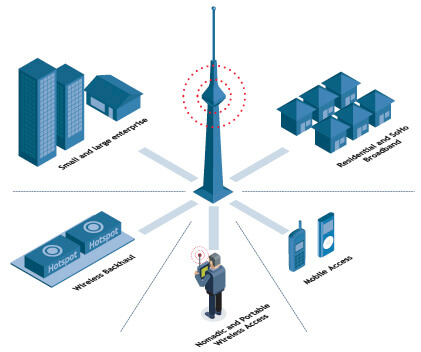Nepal Telecom is undergoing final preparations for taking the high-speed broadband internet service based on WiMAX technology to all village development committees (VDCs). WiMAX stands for Worldwide Interoperability for Microwave Access. It is a wireless communications standard designed to provide 30 to 40 megabit-per-second data rates. WiMAX is more similar to Wi-Fi than to other 3G cellular technologies. Wimax technology can also be used for voice service but NT is focusing mainly on the data segment that will have a minimum bandwidth of 256 kbps downlink and uplink. The operator announced that the services at present was being launched only for the corporate clients. Under this, hospitals, educational institution, business firms, diplomatic missions and non-governmental organizations, can now instantly subscribe to the high-internet service.Individual users, however, would have to wait for some time to subscribe the WiMAX service. “The service will be made available to individual users in and around Kathmandu valley in some time, but still our focus customers are people in rural area and the corporate sector,” NT Spokesperson Guna Keshari Pradhan said.Nepal Telecom has approved the proposal submitted by Airspan which is a US-based company and is one of the leading vendors of broadband wireless products and solutions.The WiMAX project is said to be carried out in two parts.In first part NT will build a network that covers 1,923 VDCs and 24 municipalities in Western part of the country. And, the network to be built in the Eastern part will cover 2,092 VDCs and 34 municipalities.NT further announced that it would be expanding WiMAX services to Pokhara, Bhairahawa and surrounding regions only in the second phase.
WiMAX cannot deliver 70 Mbit/s over 50 kilometers (31 mi). Like all wireless technologies, WiMAX can operate at higher bitrates or over longer distances but not both. Operating at the maximum range of 50 km (31 mi) increases bit error rate and thus results in a much lower bitrate. Conversely, reducing the range (to under 1 km) allows a device to operate at higher bitrates.Like all wireless systems, available bandwidth is shared between users in a given radio sector, so performance could deteriorate in the case of many active users in a single sector. However, with adequate capacity planning and the use of WiMAX’s Quality of Service, a minimum guaranteed throughput for each subscriber can be put in place. In practice, most users will have a range of 4-8 Mbit/s services and additional radio cards will be added to the base station to increase the number of users that may be served as required.
WiMAX and Wi-Fi have quite different quality of service (QoS) mechanisms:
- WiMAX uses a QoS mechanism based on connections between the base station and the user device. Each connection is based on specific scheduling algorithms.
- Wi-Fi uses contention access – all subscriber stations that wish to pass data through a wireless access points (AP) are competing for the AP’s attention on a random interrupt basis. This can cause subscriber stations distant from the AP to be repeatedly interrupted by closer stations, greatly reducing their throughput.
- Although Wi-Fi and WiMAX are designed for different situations, they are complementary. WiMAX network operators typically provide a WiMAX Subscriber Unit which connects to the metropolitan WiMAX network and provides Wi-Fi within the home or business for local devices (e.g., Laptops, Wi-Fi Handsets, smartphones) for connectivity. This enables the user to place the WiMAX Subscriber Unit in the best reception area (such as a window), and still be able to use the WiMAX network from any place within their residence.

In order to access the service, customers will have to buy customer premises equipment (CPE) which comes in three types–outdoor, indoor and USB dongle. Outdoor CPE, which costs Rs 16,000, will enable the subscriber access signal within a range of 15 kilometers, while indoor device priced at Rs 16,000 will facilitate signal access within 5 kilometers range.

